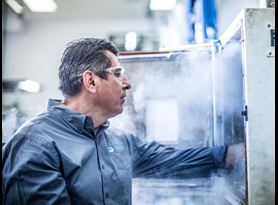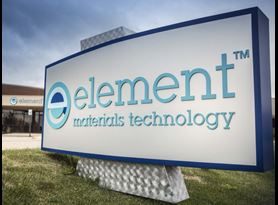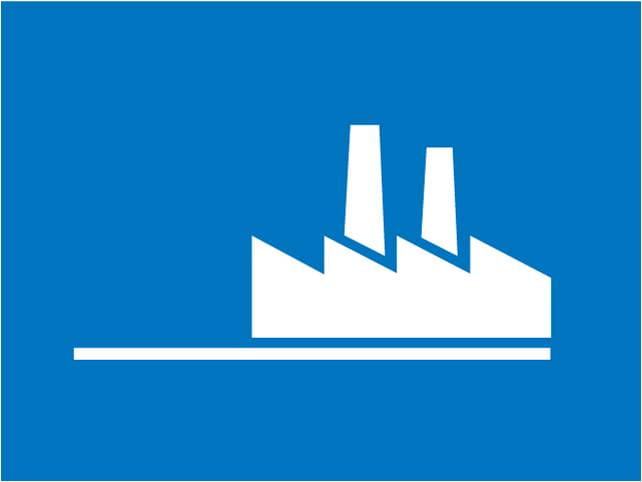Electrotechnology enclosure testing: IEC 60529 and NEMA 250
The NEMA 250 and IEC 60529 standards are internationally recognized electrotechnology enclosure tests. The IEC 60529 standard determines how well a product’s enclosure protects internal working parts from ice, dust, water, and intrusion by hands, fingers, tools, and wires. It is used for consumer safety and enclosure testing. The NEMA 250 standard is more comprehensive. It covers several operational requirements not included in the IEC 60529 standard, such as corrosion resistance and effects of icing. Here you will find an overview of each standard, followed by a comparison of the two.
IEC 60529: Dust and Water Resistance by Category
The IEC 60529 ratings use a two-digit system to delineate the level of protection that each product features. Ratings are listed as “IP__ __,” with the first digit indicating solid ingress protection, and the second digit representing liquid ingress protection. Additional letters may follow the two digits, specifying additional ingress protection.
There are six levels of solid ingress protection under the IEC 60529 rating system:
- The product is protected against intrusion by a solid object larger than 50 mm in size, such as a hand.
- The product is protected against intrusion from solid objects larger than 12.5 mm, such as a finger.
- The product is protected against intrusion of solid objects larger than 2.5 mm, such as a screwdriver.
- The product protects against intrusion by solid objects larger than 1mm, such as a wire.
- The product is protected against a limited amount of dust exposure. Dust intrusion will not interfere with product operation assuming dust exposure for two to eight hours. The “dust” used within the test is talcum powder, which is kept in suspension during testing via a circulation pump or other methods.
- Total dust protection. Dust ingress is not possible under two to eight hours of exposure.
Similarly, the IEC 60529 test system includes nine levels of water ingress protection:
- The product is protected under vertically falling water drops. Some limited ingress is allowed.
- When tilted at 15° from the vertical, the product resists vertically falling water drops. Again, limited ingress is permitted.
- When water sprays are applied up to 60° from the vertical, the product allows limited intrusion for a period of three minutes.
- The product allows limited ingress when water is splashed on it from all directions.
- Limited ingress is permitted when water jets are applied to the product.
- Heavy seawater and powerful jets of water will not enter the product in damaging quantities.
- The product is protected against the effects of water intrusion when immersed in water between 15 cm and 1 m for up to 30 minutes.
- The product withstands water intrusion when immersed in water under pressure for long periods.
- The product is protected against the effects of high-pressure and high-temperature water jets.
The above demarcations are sequential, so that each succeeding level of protection is stronger than the last. This allows each product to carry a single digit for solid and liquid intrusion. For instance, a pair of binoculars with a rating of IP67 is dust-tight and submersible for up to a half hour.
If a characteristic numeral is omitted, it is replaced with an X according to IEC code. So, a product tested only for solid ingress could be rated IP2X.
Additionally, optional letters may be added to indicate higher ingress protection. Letters A through D are used to indicate the protection against access to hazardous parts:
- A – Protected against access with the back of the hand (a 50 mm diameter access probe has adequate clearance from hazardous parts).
B – Protected against access with a finger (a jointed test finger with a 12 mm diameter and 80 mm length has adequate clearance from hazardous parts).
C – Protected against access with a tool (an access probe with a 2.5 mm diameter and 100 mm length has adequate clearance against hazardous parts).
D – Protected against access with a wire (an access probe with a 1.0 mm diameter and 100 mm length has adequate clearance from hazardous parts).
If a product is tested against hazardous access, the first letter may be replaced with an X. For example, an IPX1C rating indicates that a product withstands vertical water drips and protects the user against access with a tool.
Supplementary letters may be added to show various testing significance:
H – Indicates a high voltage apparatus.
M – Indicates movable parts are in motion during water ingress testing.
S – Indicates movable parts are stable during water ingress testing.
W – Indicates that the product withstands specified water conditions through additional protective features.
When testing against intrusion, laboratories must follow stringent guidelines specified in the IEC 60529 standard. For instance, in evaluating solid object ingress (as specified in the first digit), lab technicians must alter their approach based on the product’s voltage. For voltage less than 1000V AC and 1500V DC, the testing probe (such as a wire) must not touch the hazardous live parts. However, for voltage above 1000V AC and 1500V DC, the product must be able to endure dielectric testing even when probed in the least favorable locations.
Additionally, the IEC 60529 standard specifies application force (for solid ingress testing) and flow rates (for liquid ingress testing). As an example, to earn an IP3_ rating, a 2.5 mm rigid steel rod must not pass through any opening at a test force of 3 Newtons. Likewise, for an IP_5 rating, the product must be able to withstand water spray at 12.5 liters/minute, from a distance of 2.5 to 3 meters, via a 6.3 mm nozzle, for a minimum of three minutes.
NEMA 250: Environmental Operability Testing
There are 13 types under the NEMA 250 standard. Each type specifies a different level of protection and operability for electrical enclosures. Many of the NEMA types are sequential, with each subsequent layer adding new protection. NEMA does not conduct testing. Manufacturers have the option of displaying NEMA ratings; some choose to engage third-party labs for this purpose. The NEMA 250 rating includes standards for both hazardous and non-hazardous environments. Below, the hazardous standards are listed with an asterisk (*).
NEMA Type 1: General Purpose Indoor
For indoor enclosures under typical service conditions, NEMA type 1 testing ensures protection against falling dirt.
NEMA Type 2: Drip-Proof Indoor
For indoor operation with protection against non-corrosive liquids and falling dirt. The enclosure is designed for drainage; it prevents dripping liquid from gaining entry at the lowest electrically live part.
NEMA Type 3: Dust-Tight, Rain-Tight, and Sleet/Ice-Resistant Outdoor
Products meeting this standard safeguard equipment against windblown dust and water. They also display some ice- and sleet-resistance. To qualify for this standard, products must be waterproof at the conduit entrance. Additionally, mounting mechanisms must be outside of the equipment cavity, and there must be a locking mechanism.
NEMA Type 3R: Rainproof and Sleet/Ice-Resistant Outdoor
Additional rain protection is included. Rainproof enclosures prevent the ingress of rain above the lowest live part.
NEMA Type 3S: Dust-Tight, Rain-Tight, and Sleet/Ice-Proof Outdoor
The product can operate under ice and sleet. It can support the weight of ice, as well as ice removal via a hand tool to access the enclosure interior.
NEMA Type 4: Watertight and Dust-Tight Indoor and Outdoor
The product is protected against splashing, seeping, falling, or hose-directed water, as well as extreme condensation. This type also includes sleet and ice resistance.
NEMA Type 4X: Watertight, Dust-Tight, and Corrosion-Resistant Indoor and Outdoor
Satisfies the same requirements as type 4, but with additional corrosion resistance.
NEMA Type 5: This standard has been superseded by Type 12; see below.
NEMA Type 6: Submersible, Water-Tight, Dust-Tight, and Sleet/Ice-Resistant Indoor
Meant for products that must endure occasional submersion, this type specifies submersion under a static head of water for up to thirty minutes at a depth of six feet, in addition to being sealed against lint, water, and dust (but not sleet and ice.)
* NEMA Type 7: Class I, Division 1, Group A, B, C, or D, Indoor Hazardous Locations / Air Break
The National Electrical Code sets definitions for hazardous operation locations. In Class 1, Division 1 environments, ignitable concentrations of flammable gases, vapors, or liquids are continuously or frequently present under normal operating conditions. NEMA Type 7 enclosures are explosion proof even when hazardous gases are present in the operating atmosphere. Within this category, four different groups specify the type of gas present: acetylene (Group A), hydrogen (Group B), propane and ethylene (Group C), and benzene, butane, methane, and propane (Group D). Products that have passed NEMA Type 7 also display the corresponding group as a suffix. Enclosures in this category must also pass the UL 698 standard.
* NEMA Type 8: Class I, Division 1, Group A, B, C, or D Indoor Hazardous Locations / Oil Immersed
This standard is identical to Type 7, except that it also covers operability in oil-submersed enclosures.
* NEMA Type 9: Class II, Division 1, Group E, F, or G Indoor Hazardous Locations / Air Break Equipment
Type 9 enclosures are explosion-proof in Class II, Division I indoor environments, where ignitable levels of flammable vapors, gases, or liquids are found in the atmosphere under abnormal operating conditions. The Groups within this category correspond to atmospheric metal dust (Group E), carbon and charcoal dust (Group F), and flour, starch, wood, and plastic dust (Group G). As with Types 7 and 8, the group is specified as a suffix.
* NEMA Type 10: Mining Enforcement Safety Administration Standards for Mining Operations
Enclosures meeting this standard comply with standards set by the Mine Safety and Health Administration for safe operation in mines whose atmospheres contain methane or natural gas, with or without coal dust.
NEMA Type 11: Corrosion-resistant and Drip-Proof Oil Immersed Indoor
Enclosures that pass this standard protect enclosed equipment against seepage, dripping, and condensation of corrosive liquids. This type also includes enclosures that may be oil immersed.
NEMA Type 12: Industrial Use Dust-Tight and Drip-Tight Indoor
Enclosures with this type are protected against circulating lint, fibers, and dust, as well as falling dirt, and dripping and splashing water. Seepage and condensation are also included. This type also includes several design specifications, such as requiring no conduit knockouts without oil-resistant gaskets.
NEMA Type 13: Oil-Tight and Dust-Tight Indoor
Type 13 is akin to Type 12, but with ingress protection against splashing, spraying, seeping oil, and noncorrosive coolants. Meant mainly for pilot devices such as pilot lights, this type also protects against lint and dust, and it requires design specs such as oil-tight conduit entry.
Comparing IEC 60529 and NEMA 250 Testing
-
IEC 60529 only specifies the degree of protection for enclosures. It does not specify corrosion protection and other environmental operating requirements.
-
NEMA 250 specifies testing types not included in the IEC 60529 standard, including construction requirements, door and cover securement, corrosion resistance, effects of icing, gasket aging, oil resistance, coolant effects, and hazardous environment operation.
-
NEMA 250 testing is considered a product standard; IEC 60529 is not.
IP Testing Recommendations
The IEC 60529 and NEMA 250 test specifications are extremely detailed. For assistance in determining which levels of testing to select for your product, contact us. Element has provided world-class testing, including ingress protection and electrical enclosure testing, since 1999. Our experience allows us to advise you on the best test for your product. We can also recommend additional steps you may not have considered. For example, to facilitate inspection in compact enclosures, a UV sensitive dye can be added to water ingress testing procedures. The dye reveals ingress even in small spaces where water evaporates.
Leaders in Ingress Protection and Product Testing
Element works with each customer to determine and carry out the appropriate test(s) for each product. Our accredited product testing laboratories are fully equipped to conduct IEP 60529 and NEMA 250 testing. For these tests, our laboratories boast calibrated nozzles, immersion tanks, dust chambers, and the fluids/dust specified in the standards.
Find related Resources
More from Element

Our guide to IP code testing
IP testing can be helpful to determine if a product's exterior case or enclosure will protect the working parts from water, dust or intrusion.

Ingress Protection Testing
Element's environmental testing labs provide Ingress Protection (IP) testing to specifications including RTCA-D0-160 (avionics), MIL-STD (military), NEMA 250, IEC 60259 (electronics), DIN and SAE (automotive).

Product Testing
From environmental & dynamic testing to highly specialized tests such as bird strike and hydrodynamic ditching testing, we're the trusted testing partner to the world's most recognized component and system manufacturers.

Product Testing Laboratories
Element's product qualification testing labs span the US, UK and Germany, providing testing services to clients in Aerospace, Transportation, Oil and Gas and more.
